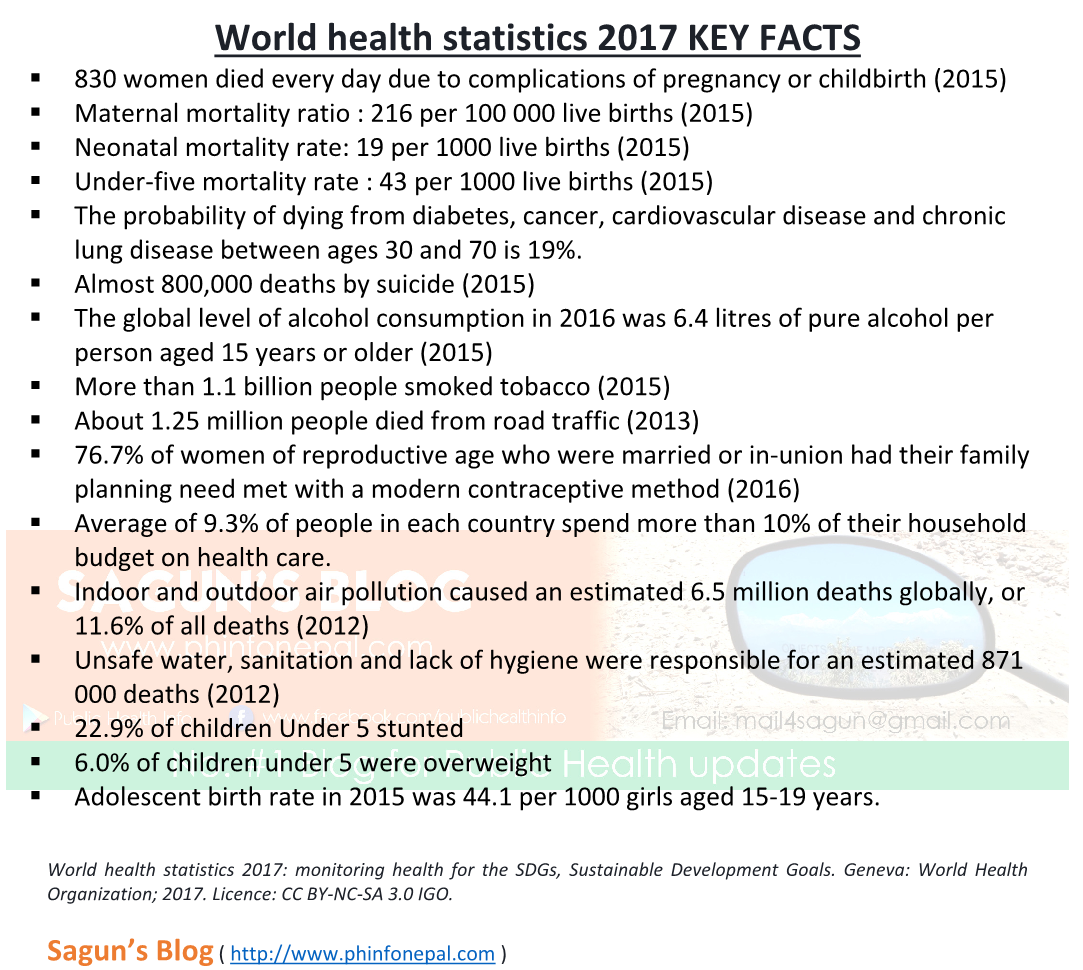The series is produced by the WHO Department of Information, Evidence and Research, of the Health Systems and Innovation Cluster, in collaboration with all relevant WHO technical departments.
World Health Statistics 2017 focuses on the health and health-related Sustainable Development Goals (SDGs) and associated targets by bringing together data on a wide range of relevant SDG indicators. In some cases, as indicator definitions are being refined and baseline data are being collected, proxy indicators are presented. In addition, in the current absence of official goal-level indicators, summary measures of health such as (healthy) life expectancy are used to provide a general assessment of the situation.
- About 830 women died every day due to complications of pregnancy or childbirth in 2015. Reducing the maternal mortality ratio from 216 per 100 000 live births in 2015 to less than 70 per 100 000 by 2030 will require more than tripling the average annual rate of decline between 1990 and 2015.
- In 2015, the global neonatal mortality rate was 19 per 1000 live births and the under-five mortality rate in 2015 was 43 per 1000 live births, representing declines of 37% and 44% respectively from 2000.
- An estimated 2.1 million people were newly infected with HIV in 2015, 35% lower than the number newly infected in 2000 (about 3.2 million).
- There were an estimated 212 million malaria cases globally in 2015. About 60% of the population at risk had access to an insecticide-treated net 2015, compared to 34% in 2010.
- The probability of dying from diabetes, cancer, cardiovascular disease and chronic lung disease between ages 30 and 70 is 19%, a 17% decline from 2000. Still, the total number of deaths from noncommunicable diseases is increasing due to population growth and ageing.
- Almost 800 000 deaths by suicide occurred in 2015, with the highest rate in the WHO European Region (14.1 per 100 000 population) and the lowest rate in the WHO Eastern Mediterranean Region (3.8 per 100 000).
- The global level of alcohol consumption in 2016 was 6.4 litres of pure alcohol per person aged 15 years or older. In 2015, more than 1.1 billion people smoked tobacco.
- About 1.25 million people died from road traffic injuries in 2013, a 13% increase from 2000. Road traffic injuries are the main cause of death for people aged 15-29 years.
2030, ensure universal access to sexual and reproductive health-care services, including for family planning, information and education, and the integration of reproductive health into national strategies and programmes.
- In 2016, 76.7% of women of reproductive age who were married or in-union had their family planning need met with a modern contraceptive method. This fell to 50% in the WHO African Region.
- The adolescent birth rate in 2015 was 44.1 per 1000 girls aged 15-19 years.
- Ten measures of essential health service coverage have improved since 2000. For example, 49% of people with TB are now detected and treated, compared with 23% in 2000, and 86% of children receive three doses of diphtheria-tetanus-pertussis vaccine, up from 72% in 2000.
- Recent data from 117 countries show that an average of 9.3% of people in each country spend more than 10% of their household budget on health care.
- In 2012, indoor and outdoor air pollution caused an estimated 6.5 million deaths globally, or 11.6% of all deaths. The Western Pacific region bore the largest burden of these deaths.
- Unsafe water, sanitation and lack of hygiene were responsible for an estimated 871 000 deaths in 2012. Most of these deaths were in the African region and the South-East Asia region.
- In 2014, average government health expenditure as a proportion of the total government expenditure was 11.7%, ranging from 8.8% in the Eastern Mediterranean region to 13.6% in the region of the Americas.
- 22.9% of children under 5 stunted (too short for their age), ranging from 6.1% in the European region to 33.8% in the Southeast Asian region.
- 6.0% of children under 5 were overweight, ranging from 4.1% in the African region to 12.8% in the European region.
- In 2014, 57% of the world’s population were reliant primarily on clean fuels, ranging from 16% in the African Region to more than 95% in the European Region
- In 2015 there were an estimated 468,000 murders, ranging from 1.7 per 100 000 in the Western Pacific region to 18.6 per 100 000 in the Region of the Americas.
- In 2015 48% of deaths were registered with a cause of death, ranging from 5% of deaths in the African region to 95% in the European region.
- Only half of WHO Member States register at least 80% of deaths with information on the cause of death.



